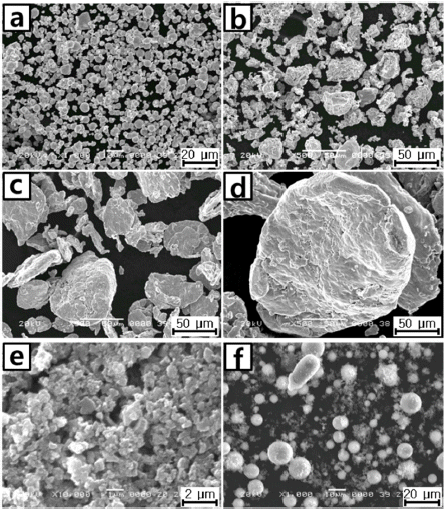Search
- Page Path
- HOME > Search
- [Korean]
- The Influence of Fe Particle Size on the Critical Properties of MgB2 Superconductor
- Hyeondeok Jeong, Dong-Gun Lee, Sung-Soo Ryu, Hai-Woong Park, Chan-Joong Kim, Byung-Hyuk Jun
- J Korean Powder Metall Inst. 2019;26(5):432-436. Published online October 1, 2019
- DOI: https://doi.org/10.4150/KPMI.2019.26.5.432

- 332 View
- 1 Download
-
 Abstract
Abstract
 PDF
PDF This study demonstrates the effect of addition of Fe particles of different sizes on the critical properties of the superconductor MgB2. Bulk MgB2 is synthesized by ball milling Mg and B powders with Fe particles at 900°C. When Fe particles with size less than 10 μm are added in MgB2, they easily react with B and form the FeB phase, resulting in a reduction in the amount of the MgB2 phase and deterioration of the crystallinity. Accordingly, both the critical temperature and the critical current density are significantly reduced. On the other hand, when larger Fe particles are added, the Fe2B phase forms instead of FeB due to the lower reactivity of Fe toward B. Accordingly, negligible loss of B occurs, and the critical properties are found to be similar to those of the intact MgB2.
- [Korean]
- Superconducting Properties and Phase Formation of MgB2 Superconductors Prepared by the Solid State Reaction Method using MgB4 and Mg Powder
- Hyeondeok Jeonga, Chan-Joong Kim, Byung-Hyuk Jun, Seolhyang Kim, Hai-Woong Park
- J Korean Powder Metall Inst. 2015;22(5):344-349. Published online October 1, 2015
- DOI: https://doi.org/10.4150/KPMI.2015.22.5.344

- 440 View
- 3 Download
-
 Abstract
Abstract
 PDF
PDF MgB2 bulk superconductors are synthesized by the solid state reaction of (MgB4+xMg) precursors with excessive Mg compositions (x=1.0, 1.4, 2.0 and 2.4). The MgB4 precursors are synthesized using (Mg+B) powders. The secondary phases (MgB4 and MgO) present in the synthesized MgB4 are removed by HNO3 leaching. It is found that the formation reaction of MgB2 is accelerated when Mg excessive compositions are used. The magnetization curves of Mg1+xB2 samples show that the transition from the normal state to the superconducting state of the Mg excessive samples with x=0.5 and x=0.7 are sharper than that of MgB2. The highest
J c-B curve at 5 K and 20 K is achieved for x=0.5. Further addition of Mg decreases theJ c owing to the formation of more pores in the MgB2 matrix and smaller volume fraction of MgB2.
- [Korean]
- Effects of Nano FexC Addition on Superconducting Properties of MgB2
- Dong-Gun Lee, Ji-Hyun Lee, Byung-Hyuk Jun, Soon-Dong Park, Young-Rang Uhm, Hai-Woong Park, Chan-Joong Kim
- J Korean Powder Metall Inst. 2012;19(2):146-150.
- DOI: https://doi.org/10.4150/KPMI.2012.19.2.146

- 302 View
- 1 Download
-
 Abstract
Abstract
 PDF
PDF - The effects of nano Fe_xC addition to superconducting properties of in situ processed MgB_2 superconductors was examined. 0.1 wt.% and 1 wt.% nano Fe_xC powders were mixed with boron and magnesium powders by ball milling. The powder mixtures were made into pellets by uniaxial pressing. The pellets were heat-treated at 700°C-900°C in argon atmosphere for MgB_2 formation. It was found by powder X-ray diffraction that the raw powders were completely converted into MgB_2 after the heat treatment. The superconducting transition temperature (T_c) and critical current density (J_c), estimated from susceptibility-temperature and M-H curves, were decreased by nano Fe_xC addition. The T_c and J_c decrease by nano Fe_xC addition are attributed to the incorporation of iron and carbon with MgB_2 lattices (Fe substitution for Mg and C substitution for B) due to the high reactivity of the nano Fe_xC powder.
TOP
 kpmi
kpmi

 First
First Prev
Prev


